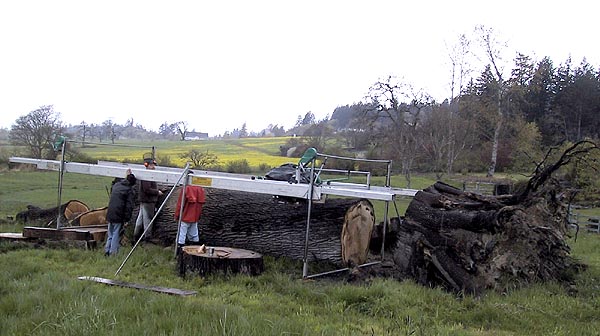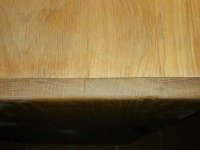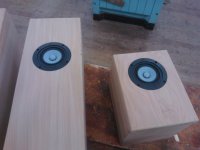Source
While not cheap, you can avoid having to build your own slabs.
John Boos | Online Store
Regards,
WHG
Im looking for solid wood, or at least finger jointed wood, for my new speakers. Having read the BBC papers in the past, Ive used birch ply in my last project. Im trying to get away from the traditional sheet materials (ive got a small 2 way using granite also in the pipeline). So far ive arrived at 2 choices, birch and beech. Does anyone have any better suggestions?
While not cheap, you can avoid having to build your own slabs.
John Boos | Online Store
Regards,
WHG
White Oak has a fungus "companion" that effectively fills its pores. The fungus does indeed aid in the woods rot resistance. Old colonial days ... white oak was used as roof shingles. George Washingtons Mount Vernon buildings still have them in place.
Red Oak doesn't share this feature. Look at end grain samples of both species and the difference is readily apparent.
Never come across red oak.
Probably because it is an american species.
You guys import an azz load of it.Never come across red oak.
Probably because it is an american species.
This is a great aborial thread!
Red Oak is new to me also, though im not generally a fan of Oak due to the open structure. White Oak would probably suit me better, if i were to opt for an Oak.
So, after a few searches i found a timber merchant local to me. Of their stock of 9 varieties, im considering US cherry, black walnut and since the last few posts, maybe also white oak.
Boards of 8inches by 1.75, priced at around 30GBP per meter. So it looks possible to make a small volume box out of few lengths, without much joining of boards.
Red Oak is new to me also, though im not generally a fan of Oak due to the open structure. White Oak would probably suit me better, if i were to opt for an Oak.
So, after a few searches i found a timber merchant local to me. Of their stock of 9 varieties, im considering US cherry, black walnut and since the last few posts, maybe also white oak.
Boards of 8inches by 1.75, priced at around 30GBP per meter. So it looks possible to make a small volume box out of few lengths, without much joining of boards.
The wider boards will tend to cup more with time. I tend to try and keep the boards less than 4" and alternate grain pattern so the boards that are joined together will want to cup in alternate directions. You might be ok with 8" by 1.75", but it would certainly be much more stable if you joined two boards that were 4" by 1.75". Just make sure to alternate the grain...
Joe
Joe
Thanks. I was a little concerned about a wider board cupping, so i also looked at 2 of 3.75 wide planed all round instead of a single board. Regarding 'alternating grain' i assume you dont mean perpendicular, and mean alternating the curve of grain. Im not THAT green, but im no master craftsman either.
P.s. I think that glue actually bonds better in most cases, doesnt weaken, split or damage the wood as screws can
P.s. I think that glue actually bonds better in most cases, doesnt weaken, split or damage the wood as screws can
Last edited:
All this talk of oak. I gave Bernie enuff Garry Oak to build a set of uFonkenSET...on his project list.
It is a protected species here -- I had an opportunity to help mill up a dead fall and took home some of the "waste". Incredibly hard wood with a very tight grain.

Old Growth Garry Oak
dave
It is a protected species here -- I had an opportunity to help mill up a dead fall and took home some of the "waste". Incredibly hard wood with a very tight grain.

Old Growth Garry Oak
dave
Thanks. I was a little concerned about a wider board cupping, so i also looked at 2 of 3.75 wide planed all round instead of a single board. Regarding 'alternating grain' i assume you dont mean perpendicular, and mean alternating the curve of grain. Im not THAT green, but im no master craftsman either.
This is the most obvious example I could find in my house. It's a white oak counter top/ kitchen island I made a while ago. You can see the board on the left is cupping toward you, and the board on the right is cupping away. Hope this helps.
edit... the boards are obviously not cupped, I should have said the grain "wants to cup"
Attachments
Last edited:
thats the cool climate for you, im sure that very northern pines spruces etc are also 'better' quality too.
Your temperatures and Daves are remarkably similar throughout the year. The difference is that he has more rain in the winter but less in the summer.
Hello chaps, kind of on topic I guess, but why does everyone use glue to hold speakers together and not screws?
http://www.diyaudio.com/forums/multi-way/216295-glue-screws.html
Your looking at the end grain for managing "cup". You'll be able to determine, usually, which side of a board would be closer to the bark by the end grain. (not so with a qtr sawn piece though). So, when you lay up a series of boards for a panel you alternate bark up ... bark down ... bark up ... bark down, etc. A board has a tendency to cup toward the inside of the tree.Thanks. I was a little concerned about a wider board cupping, so i also looked at 2 of 3.75 wide planed all round instead of a single board. Regarding 'alternating grain' i assume you dont mean perpendicular, and mean alternating the curve of grain. Im not THAT green, but im no master craftsman either.
P.s. I think that glue actually bonds better in most cases, doesnt weaken, split or damage the wood as screws can
This is all academic IMO however. It's of greater concern with table tops and other "free" formed/floating designs. A four sided case will have joinery at every corner. Mid span warpage can be managed with interior bracing ... but the bracing cannot be glued across the grain. Rather, you'd attach the brace with screws that have washers under the heads. The holes in the brace(s) are drilled over sized so the panel can move over the brace without the screws limiting panel movement.
In the design of a case like this I'd favor good overall grain match over anything else. I'd go for the full 8" width here.
One thing I never do is pre-plane any wood for future use. If you have access to the mill or a friend with a thickness planer, you're better off buying the wood rough sawn and having it planed to dimension when your ready to build it. Kiln dried wood is fine but all woods, after the kiln are subject to climate. The surfaces will take on moisture once again. If you delay surfacing as far as possible, you're removing that affected surface and a potential problem with it. You have no control over a suppliers storage arrangements.
Mid span warpage can be managed with interior bracing ... but the bracing cannot be glued across the grain. Rather, you'd attach the brace with screws that have washers under the heads. The holes in the brace(s) are drilled over sized so the panel can move over the brace without the screws limiting panel movement.
Any pictures of this? I'm having a hard time visualizing it. Thanks!
Cal, my geography knowledge is poor, but the canadian climate i experienced (montreal) was significantly cooler in winter, and better summers to boot.
Joseph, that pic illustrates it as well as possible, and that is what i was trying, poorly, to convey. Thank you.
Puppet and joeseph, you guys sum up perfectly the quandry i have. To match grain character, or not. Strangely, i was going to brace perpendicular to the grain, at least in the top and bottom panels, as i was considering a vertical windowed brace. Maybe a re-think of that strategy is required. I have alot to consider, ply would be easier, but not as satisfying. Thanks again.
Joseph, that pic illustrates it as well as possible, and that is what i was trying, poorly, to convey. Thank you.
Puppet and joeseph, you guys sum up perfectly the quandry i have. To match grain character, or not. Strangely, i was going to brace perpendicular to the grain, at least in the top and bottom panels, as i was considering a vertical windowed brace. Maybe a re-think of that strategy is required. I have alot to consider, ply would be easier, but not as satisfying. Thanks again.
Last edited:
Cal, my geography knowledge is poor, but the canadian climate i experienced (montreal) was significantly cooler in winter, and better summers to boot.
In general Canada is cold in the winter, but Victoria is under the influence of a current from Hawaii (as UK is in Caribean current) -- Canada's banana belt. Temp in winter is typically 3-10c, in the summer 15-25c. Rain in the winter, little in the summer (the monsoons are finally on us, prediction is that in the next 4 days we'll get more rain than the previous 3 months). We get maybe 7 days with snow on the ground (with a big dump every 3 or 4 years) and a couple weeks in the summer where it might push towards 30c. 1st year here i remember running across the street to Freddie the Freeloaders in my t-shirt. It is not unusual to see a mailmail wearing shorts year-round.
Montreal is 3 time zones to the East. The other end of Canada is 4 1/2 time zones away.
dave
Dave, haha yeah i think posties must have warmer blood than I! Im an islander and i forget the size of the NA continent (family historical origin is Portsmouth and Isle of Wight, both tiny islands)
Gooki, i was planning to use ply front and rear panels, glued with silicone sealant to allow some flex, as i normally do to gasket the drivers. Whether this would be free floating enough i could only speculate. Great looking cabs! New A6P? I have some original A6s that NEED cabs that gorgeous!
Gooki, i was planning to use ply front and rear panels, glued with silicone sealant to allow some flex, as i normally do to gasket the drivers. Whether this would be free floating enough i could only speculate. Great looking cabs! New A6P? I have some original A6s that NEED cabs that gorgeous!
Last edited:
If you run the grain correctly on the sides, top an bottom you should be able to glue a ply front and rear panel directly using normal wood glues (pva, or polyurethane).
Here some more pics of my cabs. And yip new AP6, marvellous sounding drivers.
http://www.diyaudio.com/forums/markaudio/216468-couple-alpair-6-builds.html
Here some more pics of my cabs. And yip new AP6, marvellous sounding drivers.
http://www.diyaudio.com/forums/markaudio/216468-couple-alpair-6-builds.html
- Status
- This old topic is closed. If you want to reopen this topic, contact a moderator using the "Report Post" button.
- Home
- Loudspeakers
- Multi-Way
- Solid wood suggestions for cabs.

